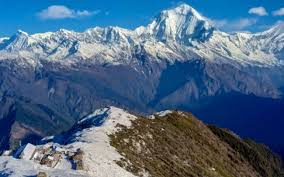
The Khopra Danda Trek has emerged as one of Nepal’s most rewarding alternative routes in the Annapurna region, offering breathtaking views without the crowds of more established trails. Choosing the right season for this trek significantly impacts the overall experience, from trail conditions to mountain visibility. While the route presents beautiful landscapes year-round, certain periods provide more favorable conditions for most trekkers exploring this hidden gem of the Annapurna Conservation Area.
Understanding seasonal variations helps adventurers plan their Khopra Danda adventure when the trails showcase their best features. The Annapurna region’s microclimates create distinct experiences across different months, each with unique advantages. Whether seeking vibrant rhododendron forests or crystal-clear Himalayan panoramas, timing your trek appropriately enhances both comfort and enjoyment along this spectacular route.
Understanding Khopra Danda’s Climate
Situated between 1,600 to 3,660 meters in elevation, the Khopra Danda Trek passes through diverse climate zones that change with the seasons. The lower sections near Tadapani feature lush forests, while the higher reaches near Khopra Ridge present more alpine conditions. These elevation variations mean trekkers may encounter different weather patterns within a single day’s hike, making seasonal awareness particularly important.
The Annapurna region follows Nepal’s typical seasonal cycle, with spring and autumn offering the most stable conditions for the Khopra Danda route. However, each season paints the landscape differently, from spring’s colorful blooms to autumn’s golden grasses. The monsoon brings life to the forests but creates challenging trail conditions, while winter transforms the route into a quieter, snow-dusted wonderland for prepared adventurers.
Spring Season (March to May)
March through May marks one of the prime windows for undertaking the Khopra Danda Trek, as nature awakens across the Annapurna foothills. Daytime temperatures range comfortably between 15°C to 20°C at lower elevations, gradually cooling as the trail ascends. This season particularly shines for nature enthusiasts, as the forests explode with colorful rhododendron blooms – Nepal’s national flower that paints the hillsides in vibrant reds and pinks.
Beyond the floral displays, spring offers excellent visibility before the monsoon clouds arrive, with crisp views of Dhaulagiri, Annapurna South, and Machhapuchhre (Fishtail Mountain). The comfortable temperatures make hiking pleasant, though early spring at higher elevations may still hold some winter chill. Wildlife becomes more active during this period, increasing chances to spot various bird species and possibly even the elusive red panda in the surrounding forests.
Autumn Season (September to November)
When the monsoon rains retreat in September, the Khopra Danda Trek enters its other peak season, renowned for stable weather and exceptional mountain views. Autumn brings the clearest skies of the year, with daytime temperatures similar to spring but with less humidity and virtually no rainfall. The post-monsoon air creates unparalleled visibility, making this the preferred season for photographers aiming to capture the Annapurna range’s majesty.
Cultural experiences also abound during autumn, as the trek coincides with major Nepali festivals like Dashain and Tihar. Trekkers may witness local celebrations in villages along the route, offering glimpses into traditional Gurung and Magar cultures. The trails remain dry and firm, and the comfortable temperatures persist through November, though nights grow progressively colder as winter approaches, especially at the higher Khopra Ridge viewpoint.
Monsoon Season (June to August)
The monsoon transforms the Khopra Danda Trek into a different kind of adventure, with daily rainfall creating challenging but lush conditions. While the persistent clouds often obscure mountain views, the landscape becomes incredibly vibrant, with waterfalls cascading down every hillside and terraced fields glowing emerald green. Fewer trekkers venture out during this period, offering solitude for those prepared to handle the wet conditions.
Trail conditions require extra caution during monsoon, with slippery paths and occasional leeches in the forested sections. However, the rains typically fall heaviest in July and August, with June sometimes offering a transitional period with less precipitation. For botanists and those interested in the region’s ecology, monsoon reveals the Annapurna region’s forests at their most lush and dynamic, with mushrooms and orchids flourishing in the damp environment.
Winter Season (December to February)
Winter presents the most challenging but potentially rewarding season for the Khopra Danda Trek, when snow dusts the higher elevations and temperatures drop significantly. While daytime hiking remains possible with proper gear (with temperatures around 5-10°C at lower elevations), nights at Khopra Ridge can plunge below freezing. The crisp winter air often provides stunningly clear views, with fewer clouds obstructing the Himalayan giants.
Fewer teahouses remain open during winter, and some higher passes may become inaccessible due to snow, requiring proper planning and equipment. However, those prepared for colder conditions will find empty trails and a magical snow-touched landscape. The winter light creates particularly dramatic photography conditions, with the sun casting long shadows across the Annapurna range’s snow-capped peaks.
Monthly Breakdown of Conditions
Examining conditions month-by-month helps fine-tune trekking plans for the Khopra Danda route. March marks the transition from winter, with improving temperatures but possible lingering snow at higher elevations. April and May offer the warmest spring conditions and peak rhododendron displays. September provides the first clear post-monsoon views, while October and November deliver the most reliable autumn weather with cooler nights.
June sees the monsoon’s arrival, with increasing rainfall through July and August. December begins the winter period, with January typically being the coldest month. February starts showing signs of spring’s approach, with slightly warmer days but still chilly nights. Each month presents trade-offs between temperatures, trail conditions, and mountain visibility that trekkers should weigh according to their priorities.
Factors to Consider When Choosing a Season
Personal preferences play a significant role in determining the ideal season for the Khopra Danda Trek. Those prioritizing mountain views will prefer autumn’s clarity, while nature lovers might favor spring’s blooms. Trekking experience also matters – beginners may find autumn’s stable conditions easiest, while experienced hikers might enjoy winter’s challenges or monsoon’s solitude.
Photography goals influence timing, too, with spring offering colorful foregrounds and autumn providing the clearest mountain backdrops. Practical considerations include teahouse availability (more limited in winter and monsoon) and trail congestion (highest during October’s peak season). The Annapurna region’s microclimates mean weather can vary, but these seasonal patterns generally hold true for planning purposes.
Wildlife and Natural Highlights by Season
The Khopra Danda Trek’s natural wonders change dramatically with the seasons. Spring brings migratory birds returning to the Annapurna region and mammals becoming more active after winter. Summer’s monsoon rains create ideal conditions for amphibians and insects, while autumn offers excellent birdwatching as species prepare for migration. Winter provides opportunities to spot hardy high-altitude species adapted to colder conditions.
Plant life follows similar seasonal rhythms, from spring’s flowers to autumn’s golden grasses and winter’s dormant forests. The Khopra Ridge itself presents different faces throughout the year – wildflower-covered in spring, green in monsoon, golden in autumn, and snow-dusted in winter. These transformations make the same trail feel like entirely different experiences across the calendar.
Conclusion
For most trekkers, spring and autumn emerge as the optimal seasons to experience the Khopra Danda Trek’s full potential in Nepal’s Annapurna region. The comfortable temperatures, reliable conditions, and excellent mountain views during these periods suit a wide range of hiking abilities and interests. However, each season casts its own spell on this beautiful route, offering unique rewards for those willing to adapt to different conditions.
Ultimately, the “best” time depends on individual preferences – whether seeking vibrant nature, cultural encounters, photographic opportunities, or peaceful trails. Whenever you choose to visit, the Khopra Danda Trek promises unforgettable Himalayan vistas and a more intimate experience of the Annapurna region away from the busier classic routes. With proper preparation for seasonal conditions, this alternative trek delivers spectacular mountain memories year-round.



